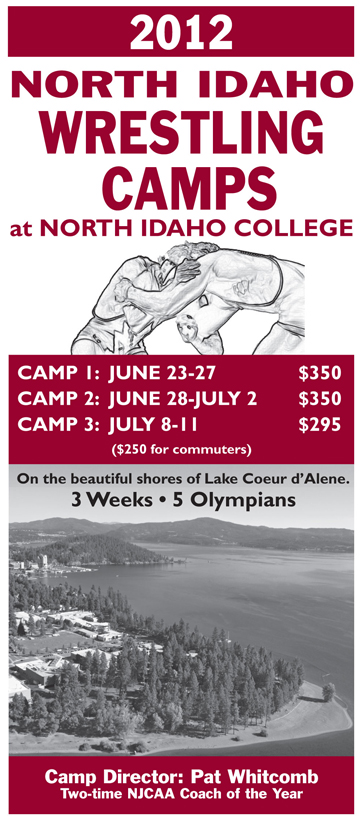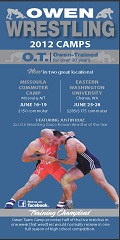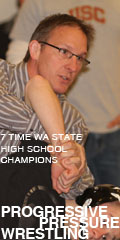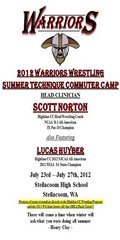How
the Predictor’s Ratings Work
By Kurt Lang—The Predictor
(1/08)
I am already getting questioned about how the rating
system in the Predictor’s computer assigns the points to wrestlers. The
explanation may seem complex, but really it all boils down to this—if a
wrestler is very active, and places well at tough tournaments, then that
wrestler will accumulate a lot of points. A very tough wrestler, who never
takes part in tournaments, and therefore never places, will not accumulate
points.
So that’s about it, in the short version. If you want a
longer explanation, have a cup of coffee, and stick around.
How I
got started at this rankings game
Back in 1996, or so, I got upset with the way the WIAA
allocated slots at the state tournament. I was a fan of wrestling in what is
called District 1 (Skagit, Snohomish, Island, San Juan, and Whatcom Counties),
and had been around the sport for more than twenty years. What upset me that
time was that the Northwest League, where some of the toughest wrestling in
the state happens, was only allowed three slots at MatClassic, while King and
Pierce County schools got five. It seemed wrong to me—I reckoned the number
four guy in the NWL could almost always beat the number one from the Metro
League. So I started looking at performance at the state tournament, which
had just begun putting results online. Lo and behold, I built a lot of
evidence that the southern schools I was targeting only rarely placed
wrestlers in the top eight, while the NWL top three virtually all placed.
I figured I was onto something.
The next season, I decided I would keep track of
returning wrestlers that had placed at state and follow them through the
season, and I expanded my scope to all of 2A (There were three classes then,
unlike the five, plus girls, now). I began to track the other divisions also.
It started as a simple spreadsheet, advanced to a full relational database
(Access), and as time has marched on, I have added more calculations. I think
more accuracy as well.
By the way, I got over my resentment about the
allotments.
The
Basic Model
I have combed through all of the MatClassic brackets
online, and recorded all of the points each wrestler has scored over the
years. Since the max a wrestled can score at that tourney in any given year
is thirty points for his team, the max for a career is 120. No wrestler has
done that—ever—but Burke Barnes was able to put together 113.
Anyway, MatClassic points are the basic unit of exchange
in my database. I could just leave it at that—and publish those totals while
leaving out a lot of other wrestlers—but what fun would that
be? Those MatClassic points, incidentally, get
multiplied by five and added to a wrestler’s rating. In the case of Burke
Barnes, that means he has 565 points, from MatClassic performance alone.
Essentially, this means that each MatClassic has a toughness rating of 150
(30x5), except for the eight-wrestler brackets (Girls and B).
But how do other tournaments
stack up? This is where the points come in again. I enter every placer from
a tournament—say the Snohomish Panther Tourney just posted on the website.
That means that I am going to add 84 records for individual places to my
database (14x6 places). Then, I use the database to compare names, and report
the number of state participants that were at the Panther (33) and the number
of points they’ve accumulated in Tacoma (141). (Compare these numbers to the
Tri-State, which had 152 places represented last year, with 2446.5 points—just
for the Washington wrestlers alone!) I also take note of the Panther’s
bracket size (16), predominant school sizes (4A/3A), and whether there were
any out-of-state teams present (no).
I also look up the same stats
for the Panther Classic in the past, to evaluate what kind of an “incubator”
the tournament is. At the conclusion of the Panther last year, for example,
there were 27 participants that had previously scored 105.5 points at Mat
Classic, but by the time MatClassic 2007 was complete, the numbers had grown
to 69 and 439.5, respectively. Put differently, the tourney has an incubator
ratio of roughly 3:1 on participants and 4:1 on points. This is slightly
higher than average in the latter case. Based on this entire group of data, I
use an algorithm (it is a long formula taking in all of the factors I have
mentioned) to assign a tourney toughness rating of 6 for this year’s version
of the Panther Classic (Last year was a 7, the year before a 5).
Now that the rating is
available, all of the 84 placers accumulate their new points, depending on
what place they got. The champs get the full 6, while other placers receive a
fraction of the 6.
Here is what one individual’s
various invitational tournament totals looked like last season:
|
Aaron “Bucky”
Snyder Kentlake HS
Graduation 2007 |
|
Tournament |
Points
earned |
Place |
Weight |
|
06 Mariner
Holiday Tournament |
11 |
1 |
160 |
|
06 Pacific
Coast Championships |
50.4 |
5 |
160 |
|
06
Rainshadow Classic |
16.8 |
3 |
160 |
|
06
Tri-State Tournament |
80.4 |
7 |
160 |
|
07 Pacific
Northwest Classic |
35 |
1 |
160 |
|
07 South
Kitsap Invitational |
2.7 |
2 |
160 |
As you can see, a championship at the Mariner Holiday
Tournament was worth about an eighth of the points for a seventh-place finish
at the Tri-State. On top of invitational tournament points, I also assign
toughness points for District and Regional championships (at a fraction of the
MatClassic possibilities); and beginning this year, National and State
Freestyle and Greco-Roman results. All scores are aggregated, and the bottom
line is what you see in the tables I published with Dave Gilbertson.
It may not be perfect, but it gives what I believe is a
pretty solid statistical picture of a wrestlers career, if not their
head-to-head toughness with another wrestler.
Some
numbers
Currently, my database has nearly 50,000 records,
including more than 11,000 individual names, more than 400 tournaments, and
whole load of placing data.
Today, I show 2,746 wrestlers as currently “active” in
the database, from 270 different high schools. This season, I have entered
placings from 75 different tournaments that
happened in 7 states.
The toughest tournament in the database is certainly The
Beast of the East (Newark, Delaware), which gets a rating of 250 (this is an
arbitrary special case—my mathematical model would have assigned it more like
a 1200 had I used the algorithm). Locally, The Tri-State is king, with a
rating this year of 222. Sorry to the Pacific Coast fans, but that tourney
only gets a rating of 84 (But still, that is the second toughest in the
Northwest after the Tri-State).
Most tournaments have a more down-to-earth rating, like
the Rogers Holiday with 12, or the Auburn Invite at 18. And few of them just
get the baseline rating of 2, because of small brackets and very low numbers
of state participants, like the Edmonds Invite, which had 4 participants for
25 points in eight-wrestler brackets. Ratings of 1 are reserved for the rare
bracket of four, or tournaments specifically designated for JV or Girls (until
I can develop more normalized statistics for that division—perhaps next
year). That brings up something else.
The
girls, small schools, and match-ups
Girls’ score are hard to come by. First off, there
aren’t that many participants—I only have 88 active in the database. Next,
some compete in tournaments alongside boys, and some do not. Finally, there is
now a separate state championship tourney exclusively for the girls. All of
these factors compound the ratings. Throw in the fact that this year,
Camie Yeik (Senior,
Olympic) can still compete with the fellas at Tacoma, and you see how tough it
can be.
The bottom line for all of my ratings is this—A
point is a point, whoever owns it. Since Camie
Yeik has a rating of 248.9, that means she has
performed just as impressively over her career as Alex Acosta (Senior, Bethel,
249.9). Similarly, Jordan Hancock (Senior, Republic, 667.0) has about the
same rating as Josh Monson (Senior, Lake Stevens, 653.9); despite the fact
that Hancock’s school is less than 10% of the size of Monson’s. They are
equally accomplished wrestlers. This does not mean, and will never
mean, that they are equally matched—only a few scrimmages and some experts can
make that call. (My guess is that it would be a good match—if they were at
the same weight.)
That should answer another question that comes up a lot.
If Wrestler A has a rating of 1000, and he or she is beaten by upstart
Wrestler B, with a rating 1.2, will B move up in points? In my system, B will
if—and only if—that particular match makes B finish ahead of A in a
tournament. I measure accomplishments, not head-to-head match-ups—and
certainly don’t have the time to dedicate to recording dual results. A couple
of years ago, I tried to do a back-of-the-envelope estimation of head-to-head
matchups each season. The total, by my rough
guess, is between 125,000 and 200,000 in Washington State. I decided not to
try to track them all. As it is, I add about 20,000 new records to the
database each season: It’s a heck of a lot of keystrokes.
Instead, I measure something you can’t find anywhere
else, unless you go to the trouble of combing through tournament data the way
I do. It paints a rough, but relatively true picture of skill levels among
wrestlers, but is definitely only an aid for ranking. I leave it to other
people to figure out who is really the best wrestler in the state.
And by the way, those other people are the wrestlers
themselves.















